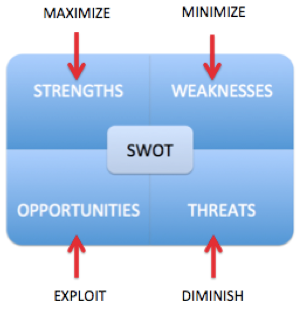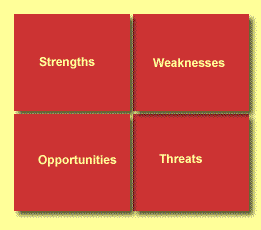by Charles Plant | Oct 11, 2012 | Management
Developing a strategy for a business is very simple when you use SWOT and combine it with the concepts of Quality, Cost and Speed.
The first step is to figure out your Strengths, Weaknesses, Opportunities and Threats for each of the three dimensions of Quality, Cost and Speed. For example:
- In terms of quality you may have a greater reliability than your competitor but less product choice. There may also be a new entrant to the market with newer technology going after a new market segment. Each of these is an element of SWOT.
- In terms of cost, you may have a more expensive product that is threatened by newer methods of production which could serve to make your competitor cheaper.
- Finally, for speed, you may have slower delivery times due to a slower manufacturing cycle time.
Figuring out strategy from SWOT would then have you do the following:

Very simply to develop strategy, you would maximize strengths, exploit opportunities, minimize weaknesses, and get rid of threats. In our simple example you might want to:
- Put in a new assembly line to lower costs of production and increase speed of delivery.
- Use the newer technology on that assembly line both to exploit new markets and broaden your product offering.
The hard part isn’t developing a strategy to beat the competition, it is figuring out what the problem really is in the first place.
by Charles Plant | Oct 2, 2012 | Exercises, Management
 Last week I looked at the topic of thinking strategically. One critical dimension of this talent is the ability to see Strengths, Weaknesses, Opportunities and Threats. SWOT. Most of us are good at recognizing strengths and perhaps next at seeing opportunities but we’re usually not very good at finding weaknesses and even worse at seeing threats. If you want to get better at critically examining SWOT in your own organization then you need to be asking yourself these questions:
Last week I looked at the topic of thinking strategically. One critical dimension of this talent is the ability to see Strengths, Weaknesses, Opportunities and Threats. SWOT. Most of us are good at recognizing strengths and perhaps next at seeing opportunities but we’re usually not very good at finding weaknesses and even worse at seeing threats. If you want to get better at critically examining SWOT in your own organization then you need to be asking yourself these questions:
Strengths
For some reason, companies always state that their strength is their people. That’s too easy an answer, a bit self-serving, and in fact it doesn’t really matter to the customer.
- What are customers really buying? Is it Quality, Cost or Speed?
- How are we better at delivering these things to customers than the competition?
Weaknesses
Many organizations don’t like to be self critical. It’s not a good feeling but you better get over the adolescent angst because if you can’t see your weaknesses, your customers can and your competitors will capitalize on them.
- How are our competitors delivering better quality, lower cost of faster service than we are?
- Where is there confusion, conflict, and missed results in our customers minds?
Opportunities
People love new ideas, seeing in them myriad opportunities for new products or services. Ideas are fun but are they real opportunities?
- How can we deliver something to customers that sets a new and vastly different standard in quality, cost, or speed of service?
- Can we disrupt a market or find an entirely new market by reducing quality and cost drastically or increasing both by big margins?
Threats
The threat for any company is that some competitor will come out of left field to dramatically change the existing paradigm.
- What are customers hidden needs that we aren’t meeting that someone else could capitalize on?
- How is the customer changing in ways that we aren’t addressing?
If you’re paying attention, you’ll notice that if you’re thinking strategically, all of these questions are about the customer, not about you. In the end, the only thing that matters in SWOT analysis is the customer.
by Charles Plant | Sep 7, 2012 | Management

As some point in your career, you’ve probably done something really stupid with email like:
- Replying to All with a snarky comment.
- Including an embarrassing long chain of confidential info when replying to someone.
- Sending something highly personal to the wrong recipient.
- Writing a nasty email that you intend to change but sending it by mistake anyway.
Take comfort. You aren’t alone. Just check out these disastrous emails that cost many people their jobs:
And have a great weekend.
by Charles Plant | Jul 18, 2012 | Management, Research
 Did you know that we’re working more but getting less done? The average work week has increased from 35 hours in 1970 to 46 hours in 2012 and three out of four Americans feel stressed at work and one out of four say that work is the most stressful part of their lives. We’re working longer hours but are we more productive?
Did you know that we’re working more but getting less done? The average work week has increased from 35 hours in 1970 to 46 hours in 2012 and three out of four Americans feel stressed at work and one out of four say that work is the most stressful part of their lives. We’re working longer hours but are we more productive?
What is the effect of these changes? Check out this post with a great infographic that Keri Damen sent me.
I’m not sure where this idea that you’re more productive working longer hours comes from. I suspect it comes from the world of lawyers, accountants, and engineers who bill their time by the hour. In their case, working longer hours results in getting paid more. For the rest of us, that isn’t the case.
If you’re a manager, your job is to get things done through other people.
If you’re doing a good job delegating responsibility and authority, there is no reason to work long hours. In fact if you are working too long you probably aren’t doing your job properly.
Working long hours means that either you are doing things yourself which is a no-no as a manager or you haven’t delegated enough authority to the people working for you. In either case, you’re not being an effective leader.
Don’t forget. Your job as a leader is to set the vision, communicate and motivate. Your job doesn’t actually entail doing any work yourself. So why are you working such long hours?
by Charles Plant | Jul 12, 2012 | Management, Video
If your day seems like one long endless meeting, you’re doing something wrong. Kerri Golden has an interesting approach, she declines meetings. The key to her approach is to figure out where she is adding value now.
If you’re getting this video in an email, click on the link to the blog to watch the video.
by Charles Plant | Jul 5, 2012 | Management
 There’s a great story about a programmer named Ron Avitzur that was pointed out to me by my Director of Content Acquisition, Lachlan Plant (aka, my son). Ron was working for Apple on a project as a contractor when the project was canned and he was terminated, fired, canned, etc.
There’s a great story about a programmer named Ron Avitzur that was pointed out to me by my Director of Content Acquisition, Lachlan Plant (aka, my son). Ron was working for Apple on a project as a contractor when the project was canned and he was terminated, fired, canned, etc.
No big deal except that Ron was really keen about completing what he was working on. What he did about it was to keep working on the project, at Apple, by keeping his old pass for a while, by sneaking in at other times, by claiming office space and resources, some of it with the cooperation of Apple staff who knew what he was doing. He even got a friend who had been terminated to work on the project as well. They both claimed they worked for each other to make sure they weren’t discovered.
They both continued on working until the project was complete, tested, and bundled with a software release as Graphing Calculator 1.0, which Apple bundled with the original PowerPC computers.
Don’t you wish you had employees with that type of initiative. A perfect counterpoint to Milton Waddams from Office Space.





